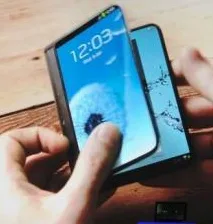The idea that a folding OLED display will somehow revolutionize portable product design and create a volcanic market expansion periodically raises its ill-conceived head. A recent occurance was the presentation by UBI Research president Choon Hoon Yi at IMID 2016 in Jeju entitled “Flexible OLED Opens New Digital Convergence.” Yi’s “digital convergence era” refers to the convergence of phone and tablet, in which the screen can be completely folded and unfolded, allowing a 5-inch phone screen to become tablet sized.

Is it possible to develop OLED displays so flexible they can be said to fold? Yes. Is it then plausible that such a display can be integrated into a “convergence” product that consumers will actually buy in large numbers? That part is questionable.
The foldable concept most people seem to think of is shown in this photo of a 2013 Samsung design demonstration. The display inside the folder wraps around both halves to make the double-sized display when the folder is opened. So, when the folder is closed, we have three thickness of display. Well, okay, polymer OLEDs are thin. We also have three thicknesses of touch panels, three thicknesses of Gorilla glass, and at least two flex circuits. You’ll probably need multiple audio drivers, microphones, and cameras so they can be pointed in the right directions when the folder is open and closed. This is becoming a rather beefy device, and consumers like their phones thin. They have also, especially in North American and Asia, enthusiastically rejected clamshell phones. And this is, no matter how you try to wriggle around it, a clamshell.
Next problem. When the device is open and in tablet mode, the screen must be rigid and flat both to provide a distortion-free image for movie watchers and a usable touch screen for swiping and typing. That means our folder can not be made of flexible, supple Corinthian leather, unless its supported with a rigid sheet of something. And the folding part has to be supported by a robust hinge that locks at 180 degrees, and perhaps at other angles, as well.
Can each of this design challenges be dealt with by clever engineers and lots of development money? They can, but in the end you are significantly compromising the user’s experience of a phone or a tablet in order to create this convergence device.
Compare it with the iPhone 7 or Samsung Galaxy S7, which are slim, sleek, polished, and very, very good at what they do. The Galaxy S7 has an OLED display and the S7 Edge has a flexible one. Of course, it is only flexed once, when the phone is assembled, but that’s enough.
In fact, while it is very easy to envision extremely useful applications for flexible OLEDs, it is very hard to envision practical applications that require the OLED to be flexed more than once. Except for one. But that’s another story.
Ken Werner is Principal of Nutmeg Consultants, specializing in the display industry, manufacturing, technology, and applications, including mobile devices and television. He consults for attorneys, investment analysts, and companies re-positioning themselves within the display industry or using displays in their products. You can reach him at [email protected].

